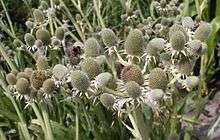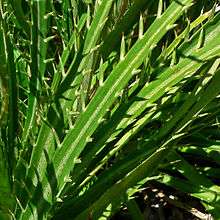Eryngium
Eryngium is a genus of flowering plants in the family Apiaceae. There are about 250 species.[1] The genus has a cosmopolitan distribution, with the center of diversity in South America.[1] Common names include eryngo and sea holly (though not to be confused with true hollies, of the genus Ilex).
| Eryngium | |
|---|---|
 | |
| Eryngium bourgatii | |
| Scientific classification | |
| Kingdom: | Plantae |
| Clade: | Tracheophytes |
| Clade: | Angiosperms |
| Clade: | Eudicots |
| Clade: | Asterids |
| Order: | Apiales |
| Family: | Apiaceae |
| Genus: | Eryngium L. |
| Species | |
|
About 250 species, see text | |
| Wikimedia Commons has media related to Eryngium. |
These are annual and perennial herbs with hairless and usually spiny leaves. The dome-shaped umbels of steely blue or white flowers have whorls of spiny basal bracts. Some species are native to rocky and coastal areas, but the majority are grassland plants.[2]
In the language of flowers, they represent admiration.[3]
Uses
Species are grown as ornamental plants in gardens. Numerous hybrids have been selected for garden use, of which E. × oliverianum[4] and E. × tripartitum[5] have gained the Royal Horticultural Society's Award of Garden Merit.
Many species of Eryngium have been used as food and medicine. Eryngium campestre is used as a folk medicine in Turkey. In Iran Eryngium (Boghnagh فارسی- بوقناق) is used as herbal tea to lower blood sugar. Eryngium creticum is a herbal remedy for scorpion stings in Jordan. Eryngium elegans is used in Argentina and Eryngium foetidum in Latin America and South-East Asia. Native American peoples used many species for varied purposes. Cultures worldwide have used Eryngium extracts as anti-inflammatory agents. Eryngium yields an essential oil and contains many kinds of terpenoids, saponins, flavonoids, coumarins, and steroids.[1]
The roots have been used as vegetables or sweetmeats. Young shoots and leaves are sometimes used as vegetables like asparagus. E. foetidum is used in parts of the Americas and Asia as a culinary herb. It is similar to coriander or cilantro, and is sometimes mistaken for it. It may be called spiny coriander or culantro.[6]
Species


|
|
References
- Wang, P., et al. (2012). Phytochemical constituents and pharmacological activities of Eryngium L. (Apiaceae). Archived 2013-11-02 at the Wayback Machine Pharmaceutical Crops 3 99-120.
- RHS A-Z Encyclopedia of Garden Plants. United Kingdom: Dorling Kindersley. 2008. p. 1136. ISBN 1405332964.
- "Language of Flowers - Flower Meanings, Flower Sentiments". www.languageofflowers.com. Retrieved 2016-11-26.
- "Eryngium × olivieranum". RHS. Retrieved 9 June 2020.
- "Eryngium × tripartitum". RHS. Retrieved 9 June 2020.
- Ramcharan, C. 1999. Culantro: A much utilized, little understood herb. p. 506–509. In: Janick, J. (ed.). Perspectives on New Crops and New Uses. ASHS Press, Alexandria, VA.
- GRIN Species Records of Eryngium. Archived 2015-09-24 at the Wayback Machine Germplasm Resources Information Network (GRIN).
- Eryngium of North America. USDA PLANTS.
